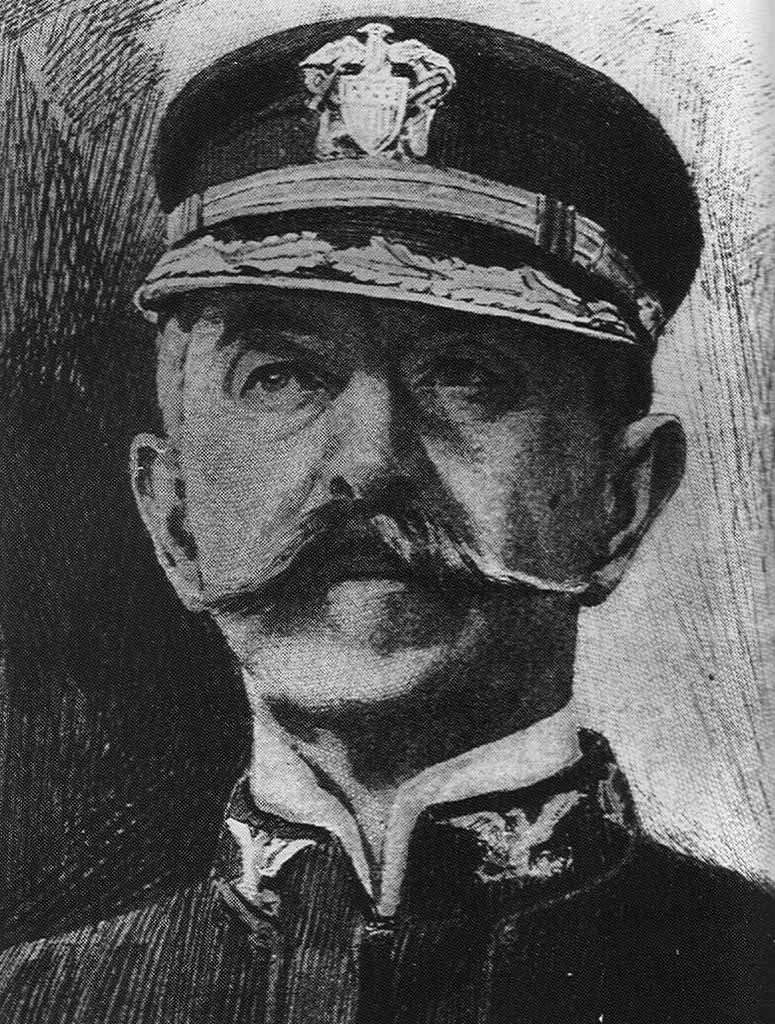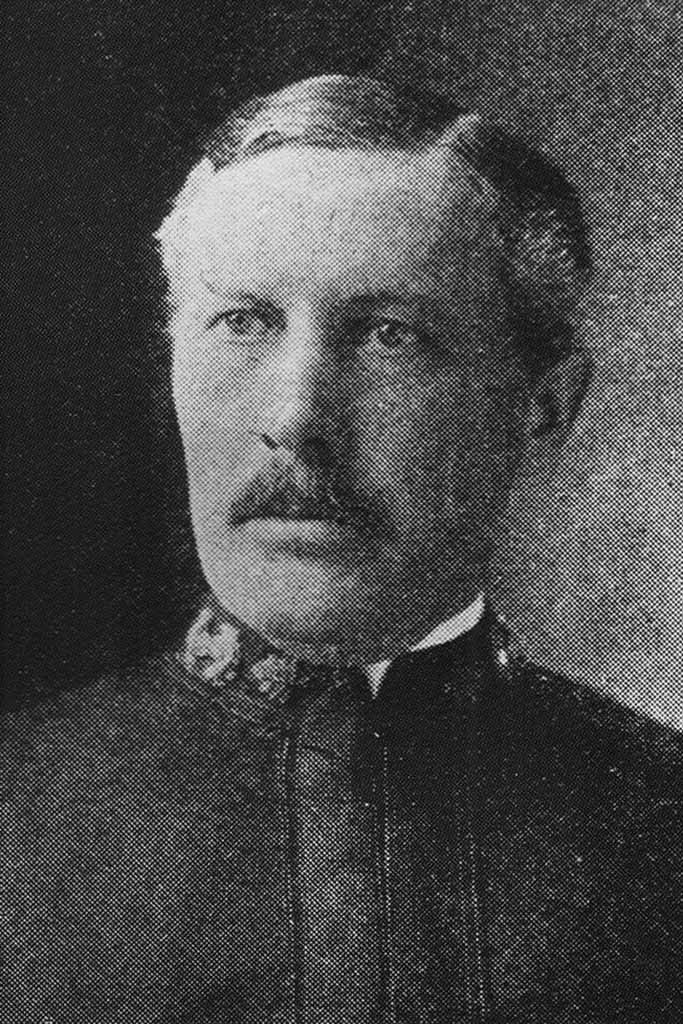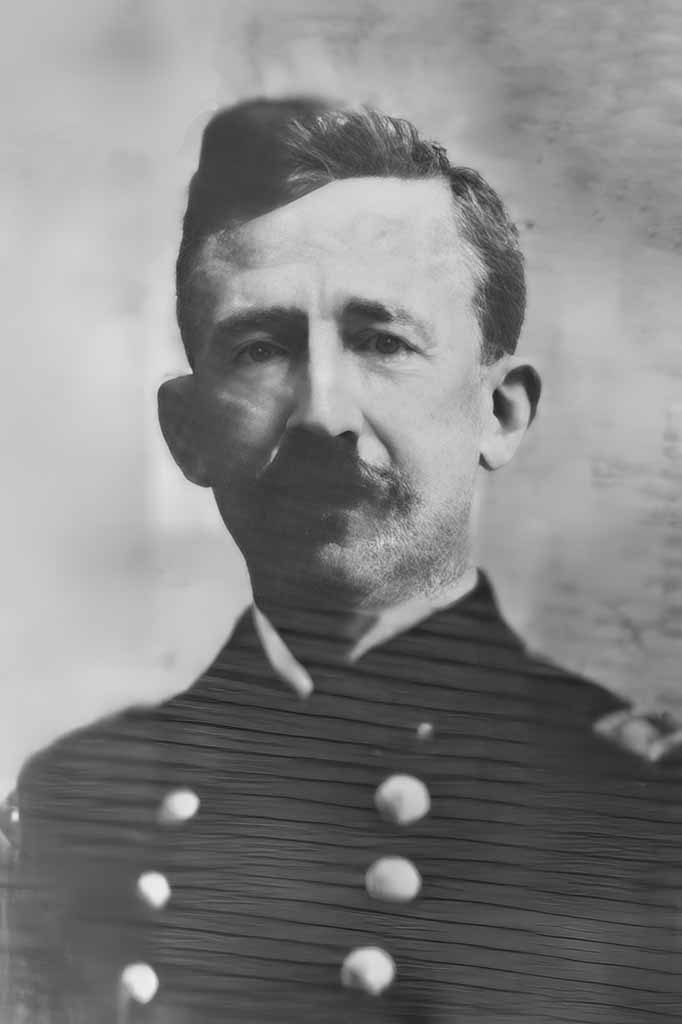Turbulent times
On 20 June 1898, during the Spanish-American War, the USS Charleston sailed past Hagåtña and steamed into Apra Harbor. Captain Henry Glass who commanded the flotilla of four ships (the Charleston, the Peking, the Sydney and the Australia) was prepared to take the Spanish held island of Guam by force if necessary.
Having no idea that Spain was at war with America, the Spanish troops offered no resistance. In fact, the Spanish thought the volley of shots from the USS Charleston was a welcome and were ashamed that they had no powder on site to return the salute.
The Spanish Governor Juan Marina surrendered and was taken as a prisoner of war along with all of the Spanish troops on the island. Having no further orders than to capture the island, the American flag was raised over Fort Santa Cruz the following day and a day later on 22 June, the ships departed. There is no written record of anyone being officially appointed to oversee the administration of the “captured” island, a fact that created a unique set of circumstances and much confusion for the people of Guam.
Francisco “Frank” Portusach (1898)
Born in Barcelona, Spain to a wealthy merchant, Francisco “Frank” Portusach moved to Chicago, Illinois after his father’s death. He became a US citizen there in 1888 and eventually moved to Guam with his American wife. In 1898 when the Spanish Garrison was “taken” by the Americans, Portusach was a clerk at Mr. Harrison’s store.
Capt. Glass is reported to have told Portusach, the only American on the island, to “take care of the island until some other officers or man-of-war might reach Guam.” Although this was never been confirmed by the US Navy, it was widely believed to be true.
Don Jose Sisto, however, immediately and successfully challenged Portusach’s authority.
Jose Sisto Rodrigo (1898)
As the administrator of the Hacienda Publica (Public Treasury), Don Jose Sisto Rodrigo claimed the Governorship based on Spanish law and the fact that he was the highest-ranking Spanish official left on the island.
Sisto claimed not only the Governorship of Guam, but made himself the provisional Governor of the Mariana Islands.
Sisto, a Filipino Spaniard, angered local residents when he released a leper from the Asan hospital. Tension between Filipino and CHamoru residents rose as Sisto’s authority was questioned. In one instance, violence broke out between the two groups at a local cockfight. Portusach broke up the argument by firing a gun.
Shortly thereafter, Portusach and a group of local citizens formed a junta, including Padre Jose Palomo, Governadorcillo don Justo de Leon-Guerrero and the tenientes (lieutenants) and cabezas de barangay (district leaders) ousted Sisto and named Venancio Roberto, a resident of Hagåtña, Governor. Sisto would later be arrested and charged with misuse of public funds.
Venancio Roberto
31 December 1898 – 2 January 1899
Appointed by the junta, Venancio Roberto’s appointment was overruled by Lt. Commander Cottman of the collier USS Brutus that arrived Guam on New Year’s Day 1899.
After listening to arguments from the opposing sides (Sisto on one side and the junta on the other) Lieutenant Cottman determined that Sisto had a legitimate claim to the office.
In essence, Roberto’s term as governor lasted less than two full days.
Jose Sisto Rodrigo
2 January – 1 February 1899
Sisto’s second term lasted less than a month. According to Augustinian Recollect Fray Francisco Sadaba del Carmen, a relative calm followed his appointment. Most likely due to the war, supplies and communications from abroad ceased. As a result, “there was little of anything” on the island.
With the arrival on 19 January 1899 of the USS Bennington and Commander Edward D. Taussig, the administration of the island was still in flux. It is reported that Cmdr. Taussig said he had not come to take possession of the island yet he began to issue directives. This confused the population even more.
Sisto issued a proclamation informing the public that a treaty of peace had been signed between Spain and the United States of America and that under the terms of this agreement, the island of Guam was now a possession of the United States.
On 1 February, Sisto officially relinquished control of the governmental and administrative affairs of the island of Guam.
Commander Edward D. Taussig
1 February 1899
On 1 February the American flag was raised over the Governor’s palace. Commander Taussig and Lt. Cottman oversaw the formal ceremony that ended with a 21-gun salute from the USS Bennington. This formally ended almost 230 years of Spanish rule on the island of Guam.
It was soon discovered that Sisto had paid himself 18 months in advance and his treasury employees 12 months in advance. The American paymaster collected the advanced funds from the employees and turned over the books to Don Vicente Herrero a few days later. The funds that Sisto advanced to himself were never collected.
Joaquin Cruz Perez
The Gobernadorcillo of Hagåtña, Don Joaquin Cruz Perez, was appointed interim Governor in mid-February by Commander Taussig. The Commander also formed a group to assist Perez with overseeing the administration of the island. In addition to Taussig and Lt. Cottman, the council was comprised of prominent island leaders including: Don Justo de Leon Guerrero (the retiring Gobernadorcillo), Don Juan Torres y Diaz, Don Luis Torres y Diaz, Padre Jose Palomo, and Don Vicente Herrero
In July of 1899 Lt. Louis Kaiser, whose orders were to conduct Navy surveillance of affairs of Guam, removed Governor Perez and appointed his successor. Kaiser was infuriated when Governor Perez handed over the keys to the Spanish arsenal to a representative of the Spanish Governor of the Northern Marianas, as was allowed under the recently signed peace treaty.
When Kaiser went to the Council with his concern they sided with the Governor. Army Commander Ewell S. Otis had suggested in a letter to Kaiser that he turn over the arms to the Spanish governor of the Northern Mariana Islands but Kaiser represented the Navy and Guam was under Navy rule. So Kaiser disregarded the suggestion and removed Perez.
William Coe
July 1899 – August 1899
Lt. Kaiser appointed William Coe to replace Perez as governor. A relative newcomer to Guam, Coe had arrived on the island the previous year just before the arrival of the USS Charleston. He served as governor for less than a month. He was to serve in other capacities under the first American governor appointed by the President of the United States.
Richard P. Leary
1 August 1899 – June 1900

President McKinley appointed USN Captain Richard Phillips Leary as the first American Governor of Guam on 12 January 1899.
On 7 August 1899 Leary, aboard the USS Yosemite, sailed into Apra Harbor. The Yosemite was to be Leary’s home for the next three months due to the condition of the Governor’s palace which he ordered to be repaired. He put his assistant, William Safford, in charge of the daily affairs of the island until the palace was fit for occupation.
His first official public act was to declare the American occupation and administration of the island. This was the first of 21 General orders that Leary made as governor.
Leary’s orders touched on many facets of the islander’s lives. From the prohibition on alcohol and gaming to prohibiting any member of his command to live with the natives “CHamoru fashion.” He outlawed “concubinage and rearing families of illegitimate children,” and forbid Carolinians to appear in public in their traditional dress (which was nearly naked). He abolished peonage and forbade the sale and transfer of land without a government permit.
All residents were required to learn to write their name by July 1900 and were encouraged to learn to read, write and speak English.
The Navy government placed public education under its control and forbade religious instruction in the schools. School became compulsory for children between the ages of eight and 14. Hospital fees were abolished and residents were encouraged to utilize the hospital.
Under Leary’s leadership, the Supreme Court of Guam was created on 15 April 1899 again under the control of the Naval governor.
CHamorus endured all of these changes with relative calm. But the order prohibiting celebration of feast days of the patron saints of villages and the expulsion of Spanish Catholic priests was met with loud and angry protests that came from as far away as the United States. But these protests did nothing to change the Governor’s order. He allowed Padre Jose Palomo, a CHamoru, to stay.
Through these general orders, Leary established the Naval governor as the supreme authority over the island. While future governor’s made changes to his general orders and instructions, only legislation passed by the US Congress could overrule the Naval governor’s authority. Until the passage of the Organic Act in 1950, Congress did not challenge the naval governor’s authority.
Leary was born 3 November 1842 in Baltimore, Maryland. He served in the Navy from 1860-1901 and retired with the rank of Commander. He died on 27 December 1901 at the Marine Hospital in Chelsea, Massachusetts.
Seaton Schroeder
19 July 1901 – 2 November 1903

Governor Seaton Schroeder pledged first to be a governor of the people and secondly, a commandant of the Navy station. Fluent in Spanish, Schroeder immediately established good rapport with the CHamoru people. He cemented his relationship with them when he eased Governor Leary’s restriction on religious feasts by allowing public celebrations.
His relations with the Carolinian population were not as warm. When his efforts to get them to conform to western dress were not successful he relocated the entire colony of about one hundred persons to Saipan.
His efforts to improve conditions in Guam were marred by natural disasters that created even more hardships for the people. The relative isolation of the island from the US as well as limited funding from the US government hampered his efforts.
In spite of these obstacles, Governor Schroeder was able to make improvements to island roads, establish the Susana Hospital, and build bridges and schools.
He encouraged agriculture and made reforms to the court system but Schroeder’s special interest was in improving the health conditions of the islanders. In addition to the Susana Hospital, a sanitary slaughter-house was built as well as an ice plant. He segregated lepers, much to the dismay of the islanders, and created programs to train midwives.
His respect for the island was exemplified with his request to the Navy Department to desist from using “Ladrone Islands” when referring to Guam. Although the official name of the islands for more than two centuries was “Mariana Islands,” Ladrone Islands was frequently appended to Guam when referring to the island. He requested that the Post Office and general American public be made aware of the fact.
Governor Schroeder forwarded to Washington DC the first CHamoru request for home rule and American citizenship thereby cementing his reputation as a friend of the people of Guam.
Schroeder was born 17 August 1849 in Washington DC Upon the completion of his term as Governor of Guam he was appointed the Chief Intelligence Officer of the Navy and achieved the rank of Rear Admiral in 1908. He served in the Navy from 1864-1911. He retired on 17 August 1911 but was recalled to active duty in 1912 and again in World War I. He died on 19 October 1922 at the Naval Hospital, Washington DC.
William Swift
11 August 1901 – 1 November 1901
Commander Swift served as acting Governor when Governor Schroeder was unexpectedly called to the United States for a brief period in 1901.
During his brief term Acting Governor Swift issued two general orders. The first announced that he was taking command while the governor was away. The second, general order Number 34 prohibited the sale of all kinds of foodstuffs in the streets and house-to-house and the “introduction, sale, or offering for sale, of all meat from animals not killed within a 3-kilometer radius of the Government House.”
Governor Schroeder had a sanitary slaughterhouse built in Hagåtña to ensure that clean and healthy meat could be obtained. An additional reason for the construction of the slaughterhouse was the presentation of an “object lesson to the townspeople who are thought to be receptive of good influences.”
Swift was born on 17 March 1848 in Windham, Connecticut. His Navy career spanned from 1863 to 1910. A court-martial in 1907 for the grounding of the battleship USS Connecticut did not seem to affect his career as he retired as a Rear Admiral and headed the “Swift Board” which reorganized the Department of the Navy prior to World War I.
William Elbridge Sewell
9 February 1903 – March 1904

Lt. Commander William Sewell served as Governor of Guam less than a year. In that time he issued twenty-four general orders.
The majority of his orders concerned taxes and fines, laws and the judicial. Governor Sewell carried on the work of the previous governor with a special interest to the revision of laws. His revisions included taxes and fines, prison law and the Criminal Code. He established game laws, and laws that addressed control of commercial corporations.
Sewell also rescinded several general orders. Among the general orders rescinded were Number 14 restricting military personnel from living with natives “CHamoru fashion,” and Number 21 which prohibited Caroline Islanders from wearing their traditional dress and prohibited cock-fighting.
He also rescinded the general orders pertaining to prohibitions of intoxicating spirituous liquors or stimulants (General orders 1, 2, 8, 32) and issued general order Number 63 which allowed the manufacture, importation, sale or disposal of intoxicating spirituous liquors under government permit or license.
Because of bleak conditions and the failure of crops, Sewell ordered a 50 percent reduction of the year’s property taxes provided that all present and delinquent taxes were paid by December 1.
Governor Sewell became ill in Guam and was transported to San Francisco aboard the US Supply. He arrived on 1 March 1904 and died 17 days later on the 18th. Governor Sewell served in the Navy from 1866-1904.
Sewell was a widower when he arrived in Guam with his three young daughters. Upon his death the children were sent to live with relatives on the east coast. His daughter, Helen, would become a well-known illustrator of children’s books. Guam made a big impression on Helen and years later she remembered:
There were sunny beaches at Guam, covered with shells and morning-glories, and the sea streaked green and cobalt, amethyst and turquoise to the reefs. I also remember well the earthquakes and tropical storms, the lizards and the bats.
For further reading
“Jose Bernardo Palomo y Torres.” In I Manfåyi: Who’s Who in Chamorro History. Vol. 1. The Hale’-ta Series. Hagåtña: Political Status Education and Coordinating Commission, 1995.
Kaiser, Louis A. “Diary of Lt. Louis A. Kaiser, U.S.N.” Unpublished manuscript, 1899. Library of Congress, Washington, DC.
Rogers, Robert. Destiny’s Landfall: A History of Guam. Honolulu: University of Hawai’i Press, 1995.
Sanchez, Pedro C. Guahan Guam: The History of Our Island. Hagåtña: Sanchez Publishing House, 1987.
US Navy Department Office of Records Administration. American Naval Occupation and Government of Guam, 1898-1902. By Henry P. Beers. Washington, DC: DONRA, 1944.





